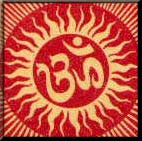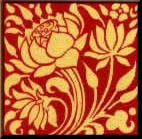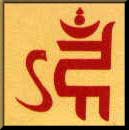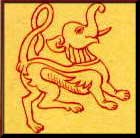|

 Six Dravyas Six Dravyas
According to Jainsim this
universe is composed of six fundamental verities; the Jain word for the universe is
"Loka" The co-existence of these six substances is called "Loka".
There are five Astikayas.
(massed verities) among these six fundamental verities. Jiva, Padgala, Dharma, Adharma
Akasa and Kala - these are the six fundamental verities. Except Kala, the five are
Astikayas. These five Astikayas can be grouped under one name Ajiva.
The Jiva dravya has 563
divisions, while the Ajiva dravya has 560 divisions. Jiva and Ajiva are included in the
nine tattvas and the six dravyas.
The universe is made of
Jiva and Ajiva. There are only two tattvas in the univese : (1) Sentient (2) Non-sentient.
Jiva is sentient, with a soul while Ajiva is non-sentient, without a soul.
There are detailed and
lucid discussions on the nature of Jiva and Ajiva in Jain literature. Ajiva dravya plays a
crucial role in the construction and management of the universe. A short discussion
follows :
Ajivatattva is not an agent
nor an enjoyer nor a sufferer and it has no soul sentience or Jiva. Like Jiva, the Ajiva
tattva is beginningless, endless and eternal. There are two main types of Ajiva - (1)
formless and (2) with a form. Dharma, Adharma, Akasa and Kala are formless, while Pudgala
has a form.
Except Kala, the other five
dravyas are called Astikayas. Astikaya means having a group of Pradeshes. The constituent
units every fundamental verity is called a Pradesha. The Kaya (mass) of Pradeshas is
Astikaya
"Astikaya is
Pradesatmaka, i.e. occupies space; hence it is called an ‘expanded entity’. Kala
is not so called because it has astiva (existance) but not Kayatva (expansion in
space)".
Dr. S.K. Belvelkar
- Brahma - Sutrabhasya 2-2-33
 Dharmastikaya
and Adharmastikaya Dharmastikaya
and Adharmastikaya
The words - Dharma and
Adharma are used here in a technical, special sense. They are not used here in the
traditional sense of good conduct and bad conduct. The peculiar meaning of these two words
in Jain religion is an original contribution of Jainism to the world.
The famous scientist Newton
was the first to accept the Principle of motion. A fruit falls down form a higher level.
Words flow from a flute. There is some medium through which a substance passes. Scientists
give the name ‘ether’ to this medium. But Bhagavan Mahavira said ago 2500 years
ago that all moving psychical states are only the subtlest vibrations. All these become
active through the help of ‘dharma’.
We are able to move through
dharmastikaya; birds can fly and fish can swim. Thus, that which helps motion is
‘Dharma’. It is a mass of pradeshas; hence it is called dharmastikaya.
Dharma helps motion, while
adharma helps inertia.
The support of Jiva or
Ajiva, which remains steady is a tattva which helps inertia. It is called Adharmastikaya.
It helps in keeping one steady.
Whatever is moving or
steady in this world is due to these two astikayas. Only Jainism uses these two words -
Dharma and Adharma, in this peculiar sense.
 Akasastikaya Akasastikaya
Akasa (space) means the
place where Jiva and Ajiva are accommodated. It is formless and supportless. All these six
dravyas are accommodated by it.
Akasastikaya is the
receptacle of all motion and inertia, Kala and Pudgalas - directions and intermediate
directions are its imaginary divisions. Pervasion is its property.
There are 2 types of Akasa.
Lokakasa and Alokakasa. That area is called Lokakasa where Dharma and Adharma, the two
helping entities in motion and inertia, reach; while infinite space, where there is no
Jiva or Ajiva is called Alokakasa.
 Pudgalastikaya Pudgalastikaya
Only Jainism has discussed,
in detail, the nature of Pudgala. The word ‘physical element’ is current, while
Jainism calls it ‘Pudgala’. The word Paramanu (atom) has become current nowadays
in science and technology. There is a well-known theory of ‘atomism’. Jainism
has discussed, the parmmanu for the first time. Pudgaladravya is divisible in small, big,
minute and coarse pieces. Jiva, Dharma, Adharma, and Akasa are non-divisible. There are no
conjuctions and disjuctions in them. Pudgala is not an impartite substance. It comes into
existence, it is destoryed. Permanent and regular change is its nature.
The smallest and minutest
form of a Pudgala is a Paramanu. The Padgala, which cannot be cut, pierced, grasped, burnt
and divided is a Paramanu.
Eight types of touch, five
types of taste, two types of smell, five types of colour - these twenty are the qualities
of a Pudgala.
Four types of
Pudgala :
(1) Skandha - The impartite
portion of a Paramanu
(2) Desa - Imaginary portion of a skandha
(3) Pradesa - an indivisible part, jointed with the skandha
(4) Parmanu - the minutest part, separate from a skandha.
There are 8 types
of a Parmanu.
When a parmanu is changed
into a skandha, it has ten forms such as word, sunshine, shade, light etc.
Jain religion has, for the
first time, called Shabda (word) a Pudgala and discussed it deeply and fully. It has for
the first time said that a word moves quickly, pervades the world, and remains steady in
the world. The concrete form of this thinking by Jainism is seen today in messages through
telegrams, phones, the radio, the T.V. etc.
 Kala
(Time) Kala
(Time)
The word
‘Time’ explained in simple and easy way, is Kala, but this is only one type.
There are 4 types of Kala.
1. Pramana Kala - An object is measured through kala hence
it is called pramana kala.
2. Yathayu nivrti
kala - life and death are
relative. The various stages of life are therefore called yathayu nivrtti kala.
3. Marana kala - The end of life is called marana kala.
4. Adda kala -
The kala conected with the motion of the
sun and the moon is called Adda Kala.
Adda Kala is the most
important division. The other three are its special forms. Adda Kala is used in practice
and it is used in the human world. For example, day-night, past tense, present tense,
future tense, etc.
The minutest part of kala
is called ‘Samaya’.
The calculation of time in
Jainism is typical and distinct. It is as follows :
* Indivisible kala - one
samaya
* Innumerable samayas - one avalika
* 256 Availikas - one ksullaka dhava
* 2223-1229/3773 avalikas - one breath
* One breath - one prana
* 7 prans - one lava
* 38 1/2 lavas - one ghadi (24 minutes)
* 77 lavas - one muhurta (48 minutes)
* 30 muhurtas - one whole day
* 15 days - one fortnight
* 2 fortnights - one month
* 2 months - one season
* 3 seasons - one half of the year
* 2 halves of the year (ayanas) - one year
* 5 years - one yuga
* 70 Krodakroda 56 lakh kroda years - one purva
* Innumerable purvas - one palyopama
* 10 krodakroda palyopamas - one sagaropama
* 20 krodakroda sagaropamas - one kalacakra
* Infinite number of kalacakras - one pudgala paravartana
The briefest form of all
these varieties of kala - today, yesterday and tomorrow.
Literature - Read
‘Navatattva,’ ‘Tattvayathasutra,’ and ‘Padarthasangraha,’
etc.
|

